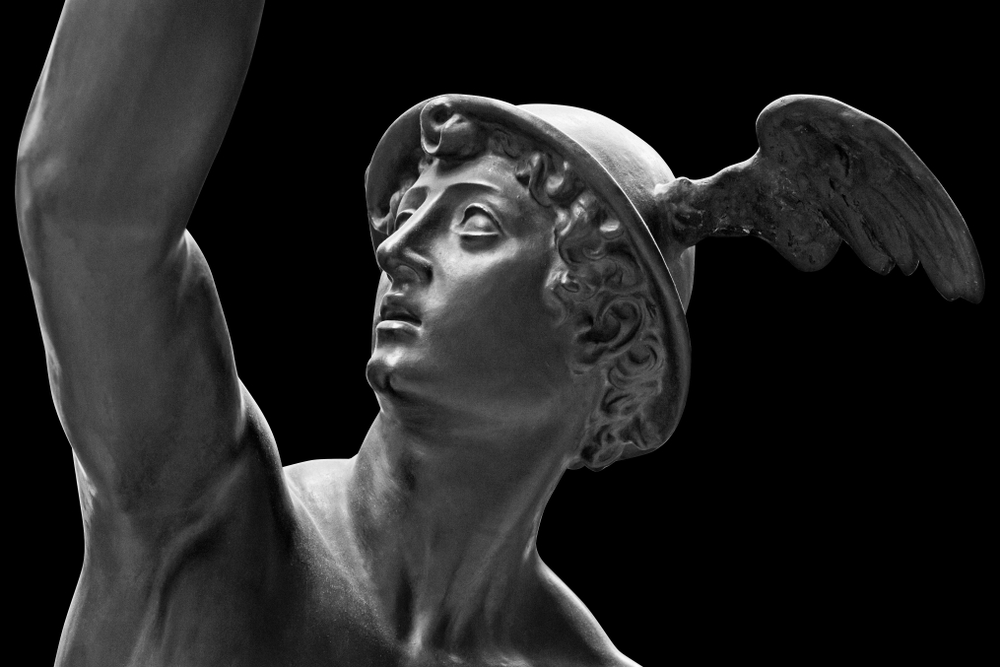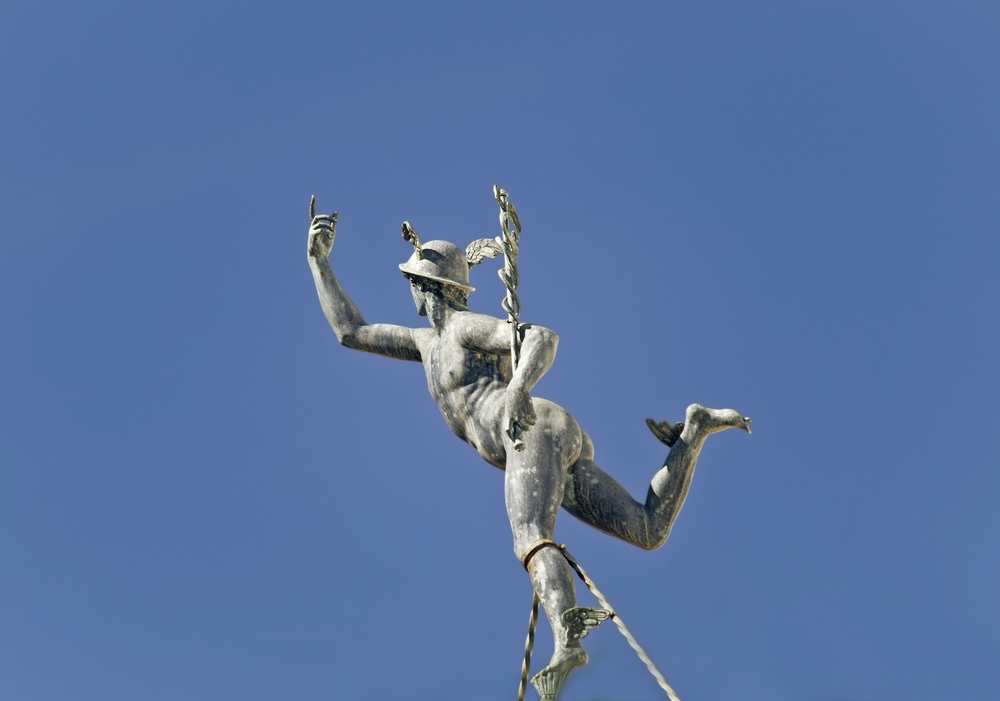Hermes, the fleet-footed messenger of the gods, is a popular figure in Greek mythology. Known for his cunning and agility, Hermes bridges the divine and the mortal, embodying a variety of roles and powers that intrigue and fascinate.
In this exploration of Hermes’ myths, powers, and symbols, we’ll delve into the stories that make him one of the most versatile Greek gods.
Jump to:
- Who Is Hermes in Greek Mythology?
- What is Hermes' Power?
- Hermes and His Myths: The Most Famous Tales
- What Are Hermes' Symbols?
- Hermes’ Relationships: Divine Connections and Familial Bonds
- Hermes’ Legacy and Cultural Influence
- Frequently Asked Questions About Hermes in Mythology
- Study Greek Mythology for £29
Who Is Hermes in Greek Mythology?

Hermes is the son of Zeus, the king of the gods, and Maia, one of the Pleiades and a daughter of Atlas. This makes Hermes a god with connections both high in the heavens and deep on the earth. Hermes' role is varied; he embodies the traits of a messenger, a guide, a protector of travellers, a god of commerce, and even a trickster.
Hermes is primarily known as the messenger of the gods, but he is also the god of trade, thieves, travellers, sports, athletes, and guide to the Underworld. This variation highlights his adaptability and the broad range of his influence.
Hermes' Personality Traits
Hermes' personality traits make him one of the most dynamic and intriguing figures in Greek mythology. He is known for his exceptional cleverness and is considered a patron of cunning and strategic thinking, often outsmarting other deities and mortals with his quick wit and intelligence. As a skilled trickster, Hermes enjoys mischief and deception, but his actions are rarely malicious.
Despite his trickster ways, Hermes is largely viewed in a positive light. His resourcefulness, adaptability, and agility make him a helpful god, one who assists both gods and mortals when the need arises. He is also known for his charisma, persuasive speech, and diplomatic skills, which enable him to mediate conflicts and bring harmony.
What is Hermes' Power?
Hermes' abilities and powers reflect his dynamic nature. His most famous attribute is his incredible speed, often depicted with winged sandals that allow him to easily travel between the worlds of gods, humans, and the dead.
Hermes' 3 Important Powers:
- Superhuman Speed & Travel: Hermes possesses unmatched speed, allowing him to serve as the messenger of the gods. His winged sandals (talaria) enable him to move freely between Mount Olympus, Earth, and the Underworld.
- God of Commerce & Trickery: Hermes is known for his cunning intelligence and persuasive abilities. He is the god of trade, merchants, and thieves, often using his wit to outsmart others.
- Guide of Souls (Psychopomp): One of Hermes' most important powers is his role as a psychopomp, guiding souls safely to the Underworld. This ability makes him a crucial figure in Greek mythology, bridging the gap between life and death.
These important powers of Hermes showcase his versatility as a deity, making him a significant figure in mythology and ancient culture.
Hermes and His Myths: The Most Famous Tales
With his winged sandals and quick wit, Hermes stars in numerous tales that highlight his roles as a messenger, inventor, guide, and trickster. These stories showcase his diverse abilities and reflect the values and concerns of the ancient Greeks. Let's delve into some of the most famous myths about Hermes.
The Invention of the Lyre
One of Hermes's most celebrated stories involves his invention of the lyre. On the day of his birth, he crafted the instrument from a tortoise shell and then used it to soothe his brother Apollo, whom he had just tricked. This tale captures Hermes' wit and resourcefulness, traits that endeared him to both gods and mortals.
Guide to the Underworld
Another significant myth involves Hermes' role as the guide to the Underworld. It was Hermes who led the souls of the deceased to the river Styx, acting as a psychopomp, a guide of souls to the realm of the dead. This duty highlights his role as a mediator between the worlds, a bridge between life and death.
The Theft of Apollo’s Cattle
Hermes executed his first trick as a newborn, showcasing his cleverness and audacity. Hours after his birth, he stole a herd of Apollo's sacred cattle. To avoid detection, he cleverly reversed their hooves, leading them backwards. When Apollo discovered the theft, he was furious but was eventually won over by the lyre's sweet music, which Hermes offered as a peace-making gift. This story illustrates both Hermes' knack for thievery and deception and his ability to reconcile and form bonds with others.
The Rescue of Io
In another tale, Hermes showcased his cunning in the service of Zeus. Tasked with rescuing Io, a maiden transformed into a cow and kept under guard by a hundred-eyed giant, Argus, Hermes used his wits and eloquence. He lulled Argus to sleep with stories and the sound of his reed pipes, then stealthily freed Io. This myth highlights Hermes' role as Zeus’ loyal servant, willing to undertake dangerous missions to help his father and protect those in distress.
What are Hermes' Symbols?

The symbols of Hermes each highlight a different aspect of his divine roles and attributes. Here’s a closer look at some of these iconic symbols:
- The Caduceus: A staff entwined with two serpents and often topped with wings, symbolising his role as a herald and messenger.
- Winged Sandals: Known as "Talaria," these sandals endowed Hermes with the ability to move swiftly between the worlds of gods, mortals, and the underworld.
- Winged Helmet: This helmet, often called a "Petasos," symbolises Hermes' speed and ability to travel great distances in the blink of an eye.
- The Tortoise: Represents Hermes' inventiveness, as he used a tortoise shell to create the lyre.
- The Rooster: A symbol of the new day, the rooster also represents Hermes’ role as a herald of the gods.
Hermes’ Relationships: Divine Connections and Familial Bonds
Hermes' Romantic Entanglements
Hermes, known for his charm and wit, had a series of romantic relationships that further highlight his character. His affairs, often resulting in the birth of various children, reflect his diverse nature and connections across Greek mythology.
- Aphrodite: Perhaps one of his most famous relationships was with Aphrodite, the goddess of love and beauty. Their union was celebrated in various myths, symbolising the harmonious blend of love and communication.
- Dryope: Hermes fell in love with Dryope, the nymph of the trees, and from their union, Pan, the god of the wild, was born. Pan inherits Hermes’ connection to nature and capacity for music.
- Peitho: In some tales, Hermes is associated with Peitho, the personification of persuasion and seduction, further emphasising his skilled eloquence and charm.
Hermes' Family: The Divine Kinship
As a son of Zeus and Maia, Hermes is part of a well-respected family.
- Zeus (Father): The king of the gods, Zeus’ relationship with Hermes involves paternal guidance and reliance on Hermes' skills as a messenger and intermediary.
- Maia (Mother): One of the Pleiades and a daughter of Atlas, Maia's union with Zeus led to the birth of Hermes. She represents a quieter aspect of divine lineage, often associated with growth and nurturing.
- Apollo (Half-Brother): Beyond their initial conflict and eventual camaraderie, Apollo and Hermes share a bond over music, prophecy, and healing.
- Artemis (Half-Sister): As Apollo’s twin sister, Artemis shares a familial connection with Hermes. While their interactions are less documented, they both play roles in guiding and protecting mortals and deities.
- Dionysus (Half-Brother): Another of Zeus’ sons, Dionysus, the god of wine and festivity, shares with Hermes a penchant for breaking boundaries and challenging norms.
Children of Hermes
Herme’s children highlight his widespread influence across Greek myths, embodying various aspects of his persona, from mischief and music to eloquence and athleticism.
- Pan: The god of the wild, shepherds, and flocks, Pan is one of Hermes’ most famous children. With his rustic appearance and playful nature, Pan embodies the wilderness and musical talents inherited from his father.
- Hermaphroditus: Born from Hermes' union with Aphrodite, Hermaphroditus symbolises the fusion of masculine and feminine qualities, reflecting the complex nature of his heritage.
- Autolycus: The son of Hermes and Chione (or sometimes said to be Philonis), Autolycus was a skilled thief and trickster, inheriting his father’s cunning and mastery of stealth. He is often celebrated for his ability to steal anything undetected.
- Tyche: In some accounts, Tyche, the goddess of fortune and prosperity, is considered a daughter of Hermes. Her association with luck and favour highlights Hermes’ influence over various facets of life and fate.
Hermes’ Legacy and Cultural Influence

Hermes's influence extends far beyond ancient myths, leaving a lasting impact on literature, art, and modern culture. In classical and Renaissance literature, he appears in works such as Homer's Iliad and Odyssey, where he guides and aids heroes like Odysseus. In Ovid's Metamorphoses, Hermes plays a role in mythological transformations, such as the story of Io. His character also inspired later literary works, including Goethe’s Faust, where Mephistopheles shares trickster qualities reminiscent of Hermes.
In the visual arts, Hermes has been a figure of fascination and inspiration, embodying the spirit of quick wit and eloquence. Ancient Greek statues, such as Hermes and the Infant Dionysus by Praxiteles, depict him as a youthful and athletic god. In Renaissance art, Hermes symbolised communication and eloquence, appearing in works like The Judgment of Paris by Peter Paul Rubens and Mercury and Argus by Diego Velázquez. His winged sandals, caduceus, and traveller's hat became iconic symbols of his agility and divine duties.
Hermes' influence extends into the modern world, where his name and attributes have been adopted by businesses and brands, symbolising speed, efficiency, and communicative prowess. Companies such as Hermès (the luxury fashion brand) and various courier and logistics services reference his swiftness and reliability. The planet Mercury, named after Hermes' Roman counterpart, reflects his attributes of speed and mobility, echoing his role as the swift messenger of the gods across the heavens.
Frequently Asked Questions About Hermes in Mythology
Is Hermes considered a patron of any particular human endeavour?
Beyond his well-known roles, Hermes is considered a patron of literature and poetry, reflecting his eloquence and wit. He's also a protector of herders and shepherds, linking him closely to rural life and agriculture.
Did Hermes have any inventions attributed to him besides the lyre?
Hermes is credited with inventing several things, including the alphabet, numbers, astronomy, and even boxing gloves. His inventive streak showcases his intelligence and versatility, touching various aspects of ancient life and culture.
Are there any festivals or traditions specifically dedicated to Hermes?
In ancient Greece, Hermes was honoured in various festivals, notably the Hermaea, which celebrated his aspects as the god of sports and athleticism. These festivals often included athletic competitions, reflecting his role as a protector of athletes.
How is Hermes represented in other cultures?
Hermes, known as Mercury in Roman mythology, was also integrated into other cultures, embodying similar roles as a messenger and mediator. His attributes and stories have parallels in Egyptian (as Thoth) and Norse (as Loki in some aspects) mythologies, illustrating the widespread appeal of his character.
What role does Hermes play in the Homeric Hymns?
In the Homeric Hymns, Hermes is depicted from birth, showcasing his cleverness, speed, and humorous disposition from a young age. The hymns emphasise his role as a mediator, trickster, and messenger, solidifying his identity in Greek religious practices.
How does Hermes interact with humans in mythology?
Hermes acts as a guide and protector for mortals, aiding heroes such as Odysseus with his wisdom and magic. His interactions are often kind, assisting in travels and transitions, embodying the ideal of a helpful deity engaged in human affairs.
What symbols are used in rituals to honour Hermes?
In rituals, symbols such as the caduceus, winged sandals, and the petasos (his hat) were used to invoke Hermes’ presence. Offerings might include incense, fruits, and even coins, reflecting his association with commerce and safe travels.
Did Hermes have any sacred places of worship?
Mount Cyllene in Arcadia, believed to be his birthplace, was a sacred site for worshipping Hermes. Additionally, herms, stone pillars topped with the god’s head, were placed at crossroads and doorways as protective markers and tributes to him.
Recommended for you!
Best SellersStudy Greek Mythology for £29
Hermes' myths offer a glimpse into the fascinating complexities of Greek mythology. If you’re captivated by these ancient stories and their modern interpretations, deepen your understanding with our Greek Mythology Diploma Course at Centre of Excellence. This fascinating course offers an in-depth exploration of the myths, legends, and cultural significance of ancient Greece. By enrolling today, you can enjoy a discounted price of just £29.













